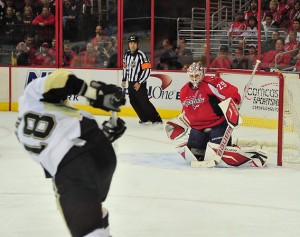If there is one thing this summer has proven about Ray Shero, it’s that he isn’t afraid to stick to his guns in the face of excruciating scrutiny. There were a lot of fans and members of the media alike calling for the Penguins to be blown up following a gut wrenching sweep at the hands of the Boston Bruins in the Eastern Conference Final. Whether Shero fired Dan Bylsma, bought out Marc-Andre Fleury or traded Kris Letang, “the experts” seemed to just want something changed. After all, this was a squad that had underachieved for the past four seasons, a result that was growing stale with the club’s fan base. Surely, Shero would recognize it was time to shake thing up.

Nope. Actually, Shero wasn’t having any of it. In fact, it didn’t take long for the Pittsburgh GM to extend Bylsma’s contract or the organization to endorse Fleury as the Penguin’s “franchise goaltender”. What’s more, as the draft approached and speculation ran rampant regarding the future of Kris Letang, Shero continued to maintain that he hoped to ultimately retain the Norris Trophy finalist. And despite what were reported to be some rocky negotiations, Shero stayed true to his word, coming to an agreement with Tanger that could keep the Penguins’ version of “The Big Three” together until 2022.
Even though Pittsburgh has locked up three of the most talented players in the world to long-term deals, Shero still faces the challenges of building a team around them. Because, at the end of the day, Sidney Crosby, Evgeni Malkin and Letang will represent the most well payed trio in the entire NHL, a fact that clearly limits the funds Shero will have at his disposal to construct the rest of the club.
That being the case, what will the Penguins’ roster look like moving forward?
Penguins’ 2013-14 Roster
Thanks to Shero’s magic and players continuing to display a willingness to take a “hometown discount” to remain in Pittsburgh, the majority of the Penguins’ forward corp is more or less set for next season. Indeed, with Chris Kunitz signing an extension and Pascal Dupuis passing on the opportunity to explore free agency, the Penguins’ “first line” is actually signed through 2017. Meanwhile, with Beau Bennett ready to embrace a larger role next season, the talented youngster looks to round out a potent top-six, likely skating alongside Malkin and James Neal. The only real short-term holes the Penguins may need to fill at the forward position come from the potential departure of character players Matt Cooke and Craig Adams. Given that the club only has about $4 million to play with, Shero isn’t likely to make much of a splash in free agency but, as THW’s Meesh Shanmugam points out, there are several free agents Shero could potentially target that may fit nicely in Western Pennsylvania.
Meanwhile, there are multiple free agent defensemen on the market, such as Andrew Ference and Rob Scuderi, that could provide an upgrade in depth to the Penguins’ roster but aren’t likely to be seriously pursued due to salary cap restraints. Instead, Simon Depres will get a chance to prove himself as a top-four defenseman as the Penguins (barring a trade) will likely enter the season with the blueliners they already have under contract:
Orpik – Martin
Depres – Letang
Engelland – Niskanen
Finally, in net, the Penguins seem content to forge ahead with Fleury and playoff hero, Tomas Vokoun. It remains to be seen how long of a leash Fleury will be given but things could get interesting should “The Flower” falter again.
Penguins’ Long-Term Outlook
The Penguins’ roster is a lot less concrete beyond the coming season – the club has only nine players signed beyond the 2013 – ’14 campaign – but Ray Shero wasn’t voted the league’s best GM for nothing. He has a propensity for making individuals see the value in playing for the Penguins’ organization while displaying the ability to consistently swing deals that put his club in a position to be successful. And that’s not likely to change.

What’s more, despite only having nine players signed beyond next year, the core is locked up for the foreseeable future. As mentioned above, the entire “first line” is signed through 2017; Neal is inked through 2018 and Crosby, Malkin and Letang will be around for the prime of their careers. So, despite the fact Pittsburgh has nearly $49 million tied up in just nine players, Shero has a lot of talent to build around. Therefore, it will be his mission to continue finding role players who simply complement the Pens’ ultra-talented core. Will it be a challenge? Absolutely; but, with the salary cap projected to shoot up following the 2013 – ’14 campaign, it’s something Shero is certainly capable of.
And while restocking a defensive unit that only has two individuals (Letang and Paul Martin) signed beyond next year is certainly a priority, Pittsburgh’s long-term goaltending situation may represent Shero’s most intriguing dilemma. Given Tomas Vokoun’s age and the fact that he is entering the final year of his contract, he is clearly not the long-term answer in net. Therefore, if Fleury continues to struggle in the postseason, Shero will need to come up with an answer for who will ultimately stand between the Pittsburgh pipes. While there are options within the system in former-Hobey Baker Finalist Eric Hartzell and the recently drafted Tristan Jarry (admittedly more of a long-term solution), neither is a sure thing at this stage. But if Fleury isn’t the goaltender of the future, Shero will be hard-pressed to determine if either of the youngsters can, in fact, become what “The Flower” once was to the Pittsburgh organization.
At first glance, all of these expensive contracts Shero has been handing out this summer may appear to be nothing more than financial handcuffs for the organization’s future. After all, they represent a huge investment in a limited amount of individuals. But, at the same time, these deals have locked up a lot of talent for that same foreseeable future and, if managed properly, promise to keep the club competitive for years to come. Perhaps Kris Letang said it best:
“Everybody in life faces decisions. Ray decided to bet on us. I think it’s the right one. We know the system, the coaches, and each other. We know what we have to do. We have to win again. But look at this team. Do you think we can’t? I will bet on us.”
Maybe he’s right; maybe one shouldn’t bet against them. Because, despite the recent playoff failures, the Penguins just locked up a core that has proven they can win. Who’s to say they can’t do it again?